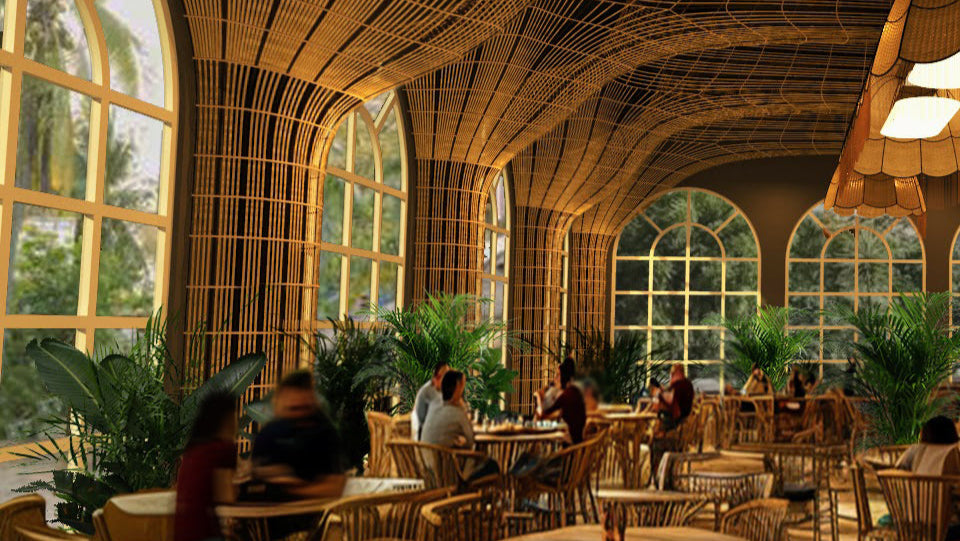
Tips for a Calm, Cosy Sanctuary : Designing with Living Materials
Mianzi TeamShare
When you switch on a lamp at dusk, your room either exhales, or tenses. The difference is rarely about wattage. It’s about the material speaking through the light: whether it feels alive, generous, quietly restorative, or synthetic, hard, and loud.
In 2025, the most serene interiors in India are not defined by maximal budgets but by kinder materials and smarter light, the sort that respects our biology, our attention, and our ecosystem. That’s where bamboo and other living fibres come in: not as trends, but as companions that soften the edge of modern life.
Lets Begin with Biology
(sophisticated interior lighting • sustainable lighting • best lamps)
Designers increasingly treat light as a circadian tool first, an aesthetic flourish second. Day-bright, cooler spectra support alertness in the morning; warm, low-intensity pools of light help the mind downshift at night. This is the essence of human-centric lighting, using spectrum, intensity, and direction to align interiors with the body’s clock and reduce stress. Evidence-backed frameworks now guide architects to balance daylight, task light, and warm ambient layers for healthier spaces.
How to use it at home:
Place bright, indirect task light where you work and cook; fade to warm, low-glare islands in the evening, pendants dimmed over dining, a floor lamp grazing a wall, a table lamp reading like candlelight beside the sofa. Main switches matter less than gentle gradients.
Choose Living Materials
(bamboo lighting • eco-friendly lighting • sustainable home decor)
When light passes through living materials: woven bamboo, grasscloth, raw paper; it scatters into delicate halos, softening edges and tempering noise. This isn’t nostalgia; it’s neuro-aesthetics. Repeated studies across biophilic design show that natural textures and patterns reduce stress, restore attention, and improve perceived comfort, effects you feel even without noticing.
Bamboo, in particular, is compelling: a rapidly renewable, CO₂-storing grass that can be harvested without replanting, then crafted into shades that filter light as if through leaves. This material story is not decorative, it’s ecological and emotional at once.
The Mood of Texture
(boho decor • unique lighting ideas)
Think of texture as a volume knob for calm. One woven pendant can carry the room’s atmosphere without crowding it, especially in neutral palettes. “Boho” becomes considered rather than chaotic when you limit the palette, vary the weaves, and let negative space breathe. Look for unique lighting ideas that read as sculpture by day and sanctuary by night: elongated linear pendants over an island, dome shades in clusters, or a fluted wall sconce that throws a soft fan of light.
Borrow from Cafés
(cafe lighting • high-end lighting design)
Cafés and boutique hotels have perfected socially warm, visually quiet lighting: low luminance at eye level, glow on vertical surfaces, and a clear hierarchy (table > wall > ceiling). Translate that at home with café lighting cues: pendants hung slightly lower over dining, wall lights that graze limewash or bamboo panels, and dim-to-warm LED bulbs for evening softness. The result feels welcoming yet composed, high-end lighting design that’s human, not theatrical. Contemporary Indian trend reports echo this blend of warmth, craft, and technology across residential and hospitality settings.
Micro-Guide: Seven Moves to a Calm & Cosy Sanctuary
Layer, don’t blast. Combine a ceiling wash with two or three best lamps placed at eye or hand height; keep brightness gentle and localized at night.
Soften the lens. Choose bamboo lighting with woven shades; the micro-textures diffuse hotspots into calm gradients.
Warm minimalism. Fewer fixtures, richer tactility. Let one sculptural pendant carry the scene; the rest should whisper.
Tune the spectrum. Use dim-to-warm LEDs where you relax; keep crisper light for tasks, sustainable lighting can still be sensorial.
Touch matters. Prioritise eco-friendly lighting made from living fibres; you’ll sense the difference even with eyes closed.
Compose for ritual. A small table lamp signals reading; a wall wash signals dinner. Lighting should choreograph your evening.
Let craft be contemporary. Pair woven shades with precise metal or stone, sustainable home decor that feels current, not rustic.
Materials as Moral Imagination
The gentlest rooms are not passive; they’re principled. A bamboo pendant is not merely a style decision, it’s an agreement to let nature’s logic shape how you live. Lived-in tactility, human-scale light, and sophisticated interior lighting choices that respect circadian rhythm all contribute to a sanctuary that steadies attention and deepens rest. When materials carry stories of regeneration rather than extraction, the room inherits that grace.
If you’re designing a hotel lounge, a café corner, or the quietest corner of your bedroom, start by asking: What does this light pass through? And what does that say about how I want to feel here? The sanctuary begins at that answer.
If this perspective resonates, pass it on to a client, collaborator, or friend planning their next project. And when you’re ready to explore bamboo lighting and other eco-friendly lighting crafted for Indian contexts, look for makers who build with living materials and human rhythms in mind—your future self will feel the difference.
